Sidney Olcott and Gene Gauntier led an American film troupe to film the life of Christ on location in Egypt and locations throughout the once and future Israel. The result was a hit but the behind-the-scenes story is deserves some attention of its own.
From Erin to Luxor
A quick note before beginning: This is film that covers an important religious subject but I will be reviewing it from a secular standpoint. I realize that your mileage may vary based on your own religious beliefs and I would never dream of trivializing or ridiculing anyone’s faith.
By the early 1910s, the American film industry was humming along nicely. The movement for feature-length films was gaining steam but most studios still preferred to add value to their productions in other ways. Kalem (founded by George Kleine, Samuel Long and Frank J. Marion—K-L-M) was based in New York but its signature prestige move was location shooting.
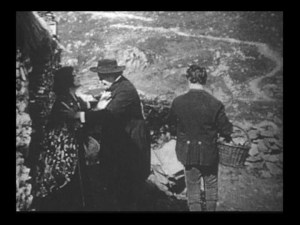
Kalem sent film teams south to Florida and west to California for varied scenery and to take advantage of the warmer, sunnier climates (using natural light during a New York winter is no joke) but the studio also allowed for more ambitious travel. Director Sidney Olcott and screenwriter/leading lady Gene Gauntier traveled to Germany and to Ireland, where the crew nicknamed themselves the O’Kalems, and shot numerous films in Europe until the outbreak of the First World War.
And since they had gone all the way to Ireland, why not mosey over to the Holy Land as well? Frank Marion sent the crew to Egypt and Palestine and the O’Kalems became the El Kalems. The plan was to make travel films, much like the pictures that had been made in Ireland, and to capture images of interest to the more religious viewers back home.

This was not the team’s first foray into religious fare. Kalem is also notable for creating a 1907 version of Ben-Hur without bothering to obtain little things like film rights. A lawsuit was brought, of course, and the result was the defining of copyright law for motion pictures. The film was shot on the cheap with painted backdrops and—apparently—a charitable event organized by a local fire brigade providing the chariots. I cover the film here.
However, the life of Christ was a completely different undertaking, one full of risks and not necessarily guaranteeing a reward.
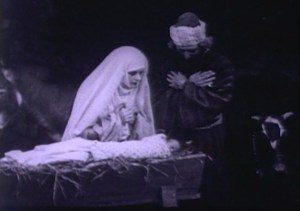
The narrative of the film is, I dare say, a pretty familiar one and so I will be going light on the synopsis this time around. The film opens with Mary and Joseph receiving angelic messages. The holy visitor is represented by a small light, a common practice in the theater. Lew Wallace was only persuaded to sell the stage rights to Ben-Hur after he was assured that the character of Jesus would be represented by a light rather than an actor. Both the 1925 and 1959 adaptations used performers but opted to avoid showing the face of the Christ.
Marion, who had come up with the idea of the El Kalem jaunt, wanted to follow the Ben-Hur example. No film should feature a physical representation of Jesus and if he was required for a scene, a light would stand in for him. However, Gene Gauntier suffered from heatstroke in Egypt and as she recovered, she realized the potential for shooting a film depicting Jesus. It was a risk but Sidney Olcott was game for it. In any case, Marion was in New York and would not have any say over the production until the final footage was delivered. (He ended up giving his blessing to the production in any case.)

The film takes its title cards directly from the Bible, so it doesn’t really add to the scriptural account but it does omit and what is omitted is interesting. For example, John the Baptist points to the approaching messiah but we are not shown the baptism; the scene of the marriage in Cana (water into wine) omits Mary’s part in the action; Jesus walks on water but Peter’s actions are cut; Mary shows up at the crucifixion scene but her son does not see to her care. Finally, the title is quite literal when it comes to the ending. There is no resurrection.
Gene Gauntier sheds light on why some of these omissions may have been necessary. In her memoirs, entitled Blazing the Trail, she states that the El Kalems felt Mary’s presence at the marriage in Cana would have been inaccurate to the customs of the time. But more significantly, the film crew was threatened by mob violence in old Jerusalem, the cause of which Gauntier and Olcott never discovered. As the additional Jerusalem scenes were not worth losing lives, the crew departed.
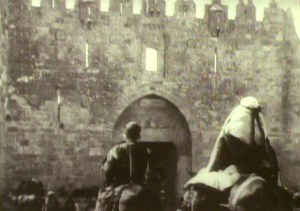
Gauntier was also responsible for the lack of resurrection. She stated that the film was meant to represent the life of Jesus of Nazareth on earth and no more. I find the decision a little baffling as her scenario presents the Christ as a holy figure. If someone raises the dead in the picture, what is wrong with showing them raised themselves later? Gauntier does not elaborate. I think it’s possible that Gauntier wanted a secular portrait of Jesus but, of course, such a thing would never have been acceptable in 1912.
I should also note that while Gauntier sometimes claimed that she was not cut out for directing, she also claimed at times that she co-directed the O’Kalem and El Kalem films (including From the Manger to the Cross) with Olcott. There is no smoking gun to prove this and we only have her contradictory testimony but I think it’s worth mentioning. From his dealings with Mary Pickford and Marion Davies, we can conclude that Olcott had an obvious problem with strong women having authority over him. It is likely that if Gauntier was co-director, she would have had to have shown caution lest she crumple Olcott’s ego.
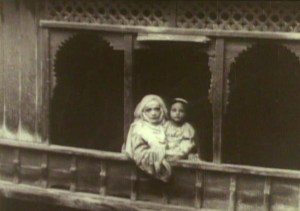
(I should also note that much of Olcott’s life is a mystery and that a large share of our information comes from Charles Foster’s dreadful Stardust and Shadows, a work of embarrassingly bad scholarship but one of the few books to include interviews of a retired Olcott. Frankly, both the interviewer and the interviewee come off as not a little nutty.)
Now that we have discussed the who, let’s talk about the how and this is where we must be a bit critical. I have seen a large share of Sidney Olcott films and… he’s a crashing bore. Look, Sidney, I know you’re busy wowing us with your telepathic powers (yes, he claimed to have them) but could you please, you know, HAVE SOMETHING HAPPEN? His films are full of events but they take forever to happen and the problem is only exacerbated by feature-length. Despite the luscious costumes, I am not inclined to rewatch Monsieur Beaucaire any time soon and not even the adorable Marion Davies could save Little Old New York from its catatonia.
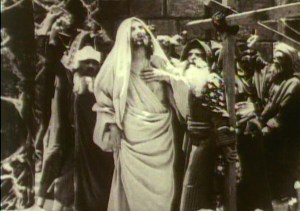
Essentially, we are watching an animated gospel and not really a movie at all. Frank Marion had purchased a copy of a Bible illustrated by James Tissot and made it clear that Olcott was to base his compositions on these images. Olcott succeeded a little too well. I realize that Olcott and Gauntier had to tread carefully but there is a remoteness that the film never quite overcomes. It all looks fabulous but the staid camerawork (we get two whole pans!) and the tendency to shoot the scenery instead of the actors does not make for a very dynamic film.
When viewing movies from the 1910s, you will soon notice that some directors were bleeding edge while others were still nailing their cameras to the floorboards and treating editing like it was an anarchist plot. It’s sometimes hard to keep track of what was a la mode and what was stodgy since everything was moving so fast in the industry. To keep myself grounded, I use what I call the Keystone Test for films released in 1912 or later. Does a Keystone comedy from the same year look more advanced than the picture you are watching? Then you’re probably seeing something stuffy.
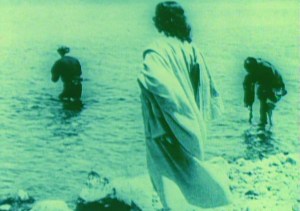
I realize that Olcott and Gauntier were concerned about offending the religious sensibilities of their audience but they also had an obligation to entertain and it is clear that the former concern eclipsed the latter. The film generally consists of long, uninterrupted scenes shot to showcase the performers head-to-toe. (Even Keystone was tossing in a medium shot or two in 1912, as well as some punchy cross-cutting.) Further, the film is absolutely stuffed to the gills with intertitles, scriptures taken directly from the King James Bible. As is always the case when a silent film is title heavy, this makes the action move along even more slowly than it would have otherwise.
Olcott seems to be taking pointers from the Italian epics of the period, though his performers lack the oomph that helped their Italian counterparts overcome any dullness in direction. Put simply, the movie is wearing them. As is the case with The Colleen Bawn, You Remember Ellen and the other Kalem productions Olcott shot on location, he relies on the scenery for interest and paces the action like he’s being paid by the yard. The Kalem acting troupe was able to generally overcome Olcott’s molasses pace in the Irish pictures but the sacred nature of From the Manger to the Cross seems to have muffled their personalities. Always a risk with religious pictures.

While the sets were being built, Olcott ventured over to England to find the perfect actor to play the lead. He settled on R. Henderson Bland, who certainly looks the part of the Europeanized Christ of popular artwork. Alas, as many a critic has quipped before me, Bland lives up to his name and while he certainly took his part seriously, there’s not much there there.
In addition to their English castmates, the El Kalems recruited any local, pilgrim or tourist who happened to cross their path. For example, the baby Jesus was played by a little boy belonging to Australian tourists. The background actors display cheerful enthusiasm for the proceedings and do not fall into the amateur trap of staring at the camera.

The Kalem team did not just shoot one picture during their North Africa/Middle East jaunt. From the Manger to the Cross was their biggest but the Olcott and Gauntier made numerous shorter films with titles like A Prisoner of the Harem, Captured by Bedouins (the Bedouins played themselves and had a grand time with the capturing), and The Fighting Dervishes of the Desert. Alas, none of these films are yet available to the general public. (As always, if you have a lead on any of Kalem’s foreign titles, please share!)
Gauntier and Olcott sent the raw footage of From the Manger to the Cross back to the Kalem offices in New York. Unfortunately, there was trouble brewing at the home. The film proved to be a success but Kalem refused to pay or credit Olcott and Gauntier accordingly. They left and took most of the O’Kalems with them. Gene Gauntier formed her own company but the war and the rising studio system made launching a new brand enormously challenging. Olcott ended up working as a studio director until 1927, Gauntier retired in 1915 but returned once for a part in The Witch’s Gold (1920).

Kalem didn’t last much longer. Like so many of its pre-feature counterparts, it couldn’t deal with longer film production and the star system. Despite the success of From the Manger to the Cross, the appeal of feature films eluded them. Why would anyone want films of five reels when they had been satisfied with one or two for years? Well, we know the answer. Kalem was sold to Vitagraph in 1917. (Home video editions of From the Manger to the Cross are credited to Vitagraph or to Warner Brothers, which later purchased Vitagraph, for this reason.)
From the Manger to the Cross had been made on the cheap—the crew paid for their foreign jaunt with the shorter melodramas they sent back—but it yielded enormous box office rewards. These rewards opened the film to criticism, particularly in England, where members of the clergy openly wondered whether it was sinful to profit from the life and death of Jesus.
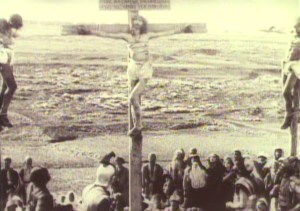
However, it was a member of the English clergy that possibly rescued From the Manger to the Cross from becoming a lost film. A vicar named Brian Hession obtained a copy of the picture, added narrative voiceover and reissued it. Okay, so not exactly pristine preservation but the fact remains that most silent films die either in fire or rot away because they have been forgotten. Making copies and distributing them hither and yon is one of the best was to assure a film’s survival.
Graham Greene wrote that Hession also inserted a shot of the empty tomb and introduced closeups. Greene further states that closeups were invented by D.W. Griffith in 1913 and that’s why Olcott did not use them in the 1912 original. In fact, closeups were an old hat in 1913, Olcott didn’t use them because he preferred not to. The claim is so ridiculous that I am feeling second-hand shame for Greene.
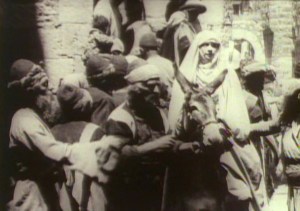
Despite the efforts of Rev. Hession, I can’t recommend From the Manger to the Cross to anyone but Sidney Olcott fans (but they’ve probably already flounced off), Gene Gauntier devotees (that’s me) and students of the religious film in cinema history. The movie deserves praise for its location shooting but Olcott’s direction is leaden and it would take more than a miracle to save it.
Where can I see it?
From the Manger to the Cross (sans the Hession additions) has been released on DVD by Flicker Alley as a double feature with Alice Guy’s The Life and Passion of Jesus Christ. The film features a fine organ score by Timothy Howard.
***
Like what you’re reading? Please consider sponsoring me on Patreon. All patrons will get early previews of upcoming features, exclusive polls and other goodies.

It looks like a beautiful film! Thank you for sharing!
Always glad to pass the word 🙂